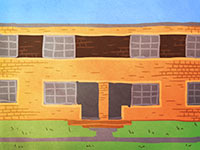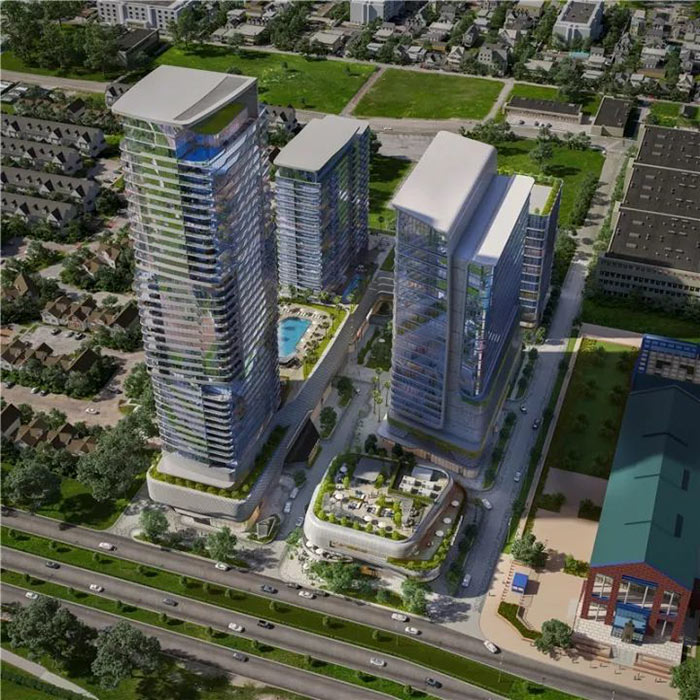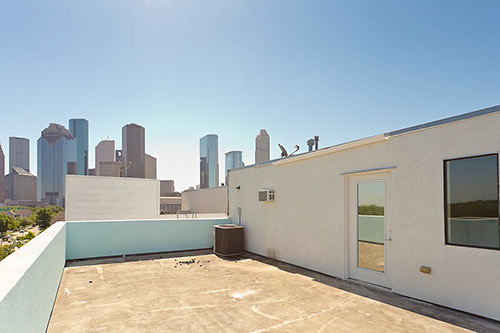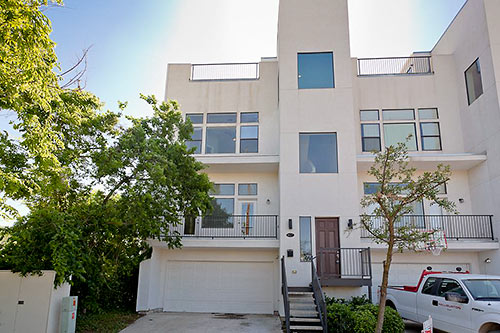COMMENT OF THE DAY: A QUICK ALLEN PARKVIEW VILLAGE RECAP FOR HOUSTON NEWCOMERS  “. . . Back in the 1920s, the 4th Ward was Houston’s version of Harlem during the Harlem Renaissance. Racist white city officials did not want a thriving African American community right next to a rapidly growing downtown and demolished a huge section of the community to build public housing (the decisive blow to the 4th ward would be extending the freeway through the community, effectively cutting it off from downtown). APV was designed by MacKie & Kamrath and was intended to be public housing. It ended up as all white housing for veterans. Eventually, African Americans moved in as whites moved out and headed to the suburbs. In the ’70s, as the City was booming again, City officials wanted to demolish APV as it, and much of the rest of the 4th ward, was falling into disrepair. Every single move after that was just controversy on top of controversy. The City was accused of moving Vietnamese immigrants into APV to dilute the number of African Americans who opposed demolition. Then, there was a big master plan project proposed to redevelop the entire area, a court case over demolition of APV and designation of APV and the Fourth Ward on the national register of historic places. In the end, more than half was demoed and replaced with new apartments in 2000. The original MacKie & Kamrath designed buildings are architecturally and historically significant. But, like the history of the 4th ward, Houston’s transient population knows very little about the trials and tribulations behind APV. So, it is an easy target to troll for hate on preservationists.” [Old School, commenting on Comment of the Day: An Alternative Plan for the Site Next to Allen Parkway Village] Illustration: Lulu
“. . . Back in the 1920s, the 4th Ward was Houston’s version of Harlem during the Harlem Renaissance. Racist white city officials did not want a thriving African American community right next to a rapidly growing downtown and demolished a huge section of the community to build public housing (the decisive blow to the 4th ward would be extending the freeway through the community, effectively cutting it off from downtown). APV was designed by MacKie & Kamrath and was intended to be public housing. It ended up as all white housing for veterans. Eventually, African Americans moved in as whites moved out and headed to the suburbs. In the ’70s, as the City was booming again, City officials wanted to demolish APV as it, and much of the rest of the 4th ward, was falling into disrepair. Every single move after that was just controversy on top of controversy. The City was accused of moving Vietnamese immigrants into APV to dilute the number of African Americans who opposed demolition. Then, there was a big master plan project proposed to redevelop the entire area, a court case over demolition of APV and designation of APV and the Fourth Ward on the national register of historic places. In the end, more than half was demoed and replaced with new apartments in 2000. The original MacKie & Kamrath designed buildings are architecturally and historically significant. But, like the history of the 4th ward, Houston’s transient population knows very little about the trials and tribulations behind APV. So, it is an easy target to troll for hate on preservationists.” [Old School, commenting on Comment of the Day: An Alternative Plan for the Site Next to Allen Parkway Village] Illustration: Lulu
Tag: Allen Parkway Village
COMMENT OF THE DAY: AN ALTERNATIVE PLAN FOR THE SITE NEXT TO ALLEN PARKWAY VILLAGE  “. . . In an ideal world, I think that the City should’ve recognized that there was an opportunity for the HHA to acquire this site and work with a private-sector master developer to completely demolish the existing complex and integrate government housing into a much more intensively developed project on this extremely high-profile site. Doing so would’ve bypassed some of the issues that they’ve since encountered with the adverse SCOTUS ruling. It wouldn’t have been cheap, but it would’ve also tastefully incorporated government housing into a project that could have mitigated the externality of APV on the areas around it and established an open street grid. Doing so would’ve made everything around there and along the Buffalo Bayou much more desirable and accessible, and leveraged the tax base upward over a large area. However, that also wouldn’t have been uncontroversial; some people think that the original Allen Parkway Buildings are architecturally significant enough to warrant their preservation. In any case, that ship probably has sailed. . . .” [TheNiche, commenting on Your Best Look Yet at the Shiny Highrises Fitting Between Allen Parkway Village and the Federal Reserve] Image: Tianqing Real Estate Development/DC Partners
“. . . In an ideal world, I think that the City should’ve recognized that there was an opportunity for the HHA to acquire this site and work with a private-sector master developer to completely demolish the existing complex and integrate government housing into a much more intensively developed project on this extremely high-profile site. Doing so would’ve bypassed some of the issues that they’ve since encountered with the adverse SCOTUS ruling. It wouldn’t have been cheap, but it would’ve also tastefully incorporated government housing into a project that could have mitigated the externality of APV on the areas around it and established an open street grid. Doing so would’ve made everything around there and along the Buffalo Bayou much more desirable and accessible, and leveraged the tax base upward over a large area. However, that also wouldn’t have been uncontroversial; some people think that the original Allen Parkway Buildings are architecturally significant enough to warrant their preservation. In any case, that ship probably has sailed. . . .” [TheNiche, commenting on Your Best Look Yet at the Shiny Highrises Fitting Between Allen Parkway Village and the Federal Reserve] Image: Tianqing Real Estate Development/DC Partners
COMMENT OF THE DAY: A BRIEF ANNOTATED HISTORY OF ALLEN PARKWAY VILLAGE’S DIRTY NEIGHBOR  “Wow, I never knew there was a waste incinerator right in the Fourth Ward. Here’s a handy timeline:
Post-Civil War: Freed slaves construct their own neighborhood in the Fourth Ward.
1917: Camp Logan Race Riots are sparked off when a Houston policeman beats a black soldier in the Fourth Ward.
1920s: Gillette incinerator is built (PDF) right in the Fourth Ward.
1944: San Felipe Courts (today’s Allen Parkway Village) were built next to the incinerator. They were originally intended as public housing for the city (following a New Deal movement for public housing in the 1930s) but ended up being handed over to the defense department to exclusively house white WW2 veterans (PDF). The other motivation was to ‘clean up the slums’ along Allen Parkway for passing commuters.
1964: San Felipe Courts are desegregated following the Civil Rights Act and renamed to Allen Parkway Village.
1970s-90s: Developers advocated for APV’s demolition arguing that the public housing’s costs didn’t reflect the land’s ‘highest and best use.’ Meanwhile, the housing deteriorated due to neglect by the Houston Housing Authority and HUD. Residents organized and protested demolition leading to APV’s rebuilding in 1997.
Today: The city can now cash in by selling a plot of polluted land next to APV now that the Fourth Ward is gentrifying.” [Carpetbagger, commenting on The Best the City Can Get for Gillette; Not Jus Donuts’ Extreme Cakeover] Illustration: Lulu
“Wow, I never knew there was a waste incinerator right in the Fourth Ward. Here’s a handy timeline:
Post-Civil War: Freed slaves construct their own neighborhood in the Fourth Ward.
1917: Camp Logan Race Riots are sparked off when a Houston policeman beats a black soldier in the Fourth Ward.
1920s: Gillette incinerator is built (PDF) right in the Fourth Ward.
1944: San Felipe Courts (today’s Allen Parkway Village) were built next to the incinerator. They were originally intended as public housing for the city (following a New Deal movement for public housing in the 1930s) but ended up being handed over to the defense department to exclusively house white WW2 veterans (PDF). The other motivation was to ‘clean up the slums’ along Allen Parkway for passing commuters.
1964: San Felipe Courts are desegregated following the Civil Rights Act and renamed to Allen Parkway Village.
1970s-90s: Developers advocated for APV’s demolition arguing that the public housing’s costs didn’t reflect the land’s ‘highest and best use.’ Meanwhile, the housing deteriorated due to neglect by the Houston Housing Authority and HUD. Residents organized and protested demolition leading to APV’s rebuilding in 1997.
Today: The city can now cash in by selling a plot of polluted land next to APV now that the Fourth Ward is gentrifying.” [Carpetbagger, commenting on The Best the City Can Get for Gillette; Not Jus Donuts’ Extreme Cakeover] Illustration: Lulu


The rooftop terrace of this 2008 City View Courtyard townhome ought to be a decent spot for watching tomorrow’s Freedom Over Texas fireworks show. The Fourth Ward location between W. Dallas St. and the back of Allen Parkway Village falls in Freedmen’s Town — though not the portion designated and nationally registered as Freedmen’s Town Historic District. The townhome property’s name is only semi-apt; while “city view” (top) is a sure thing, the “courtyard” reference is less clear. Perhaps it refers to the narrow strip of fenced pens between the 2 back-to-back 3-packs? Even without the seasonal pyrotechnics of Houston’s Official July 4th Celebration to view, the end-cap’s perspective peeks at office peaks, . . .

